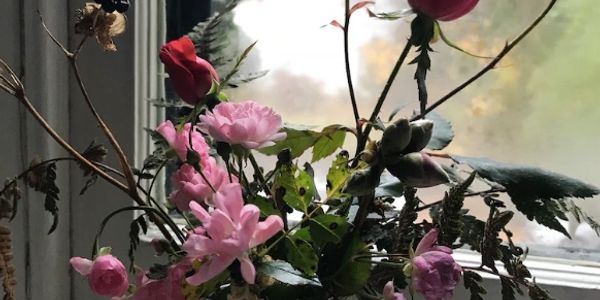
A Writing Life

Journey
When I was younger, someone told my mother that I should watch out. You see, at times I would learn this, and that, and then the other thing, and never go a mile deep into any of them. This could be a problem when I grew up, this person warned. They used a playing-cards metaphor: you're on your way to a full house, but you end up short, holding two jacks, two queens and a four.
It turns out that this know-it-all advice-giver was 100% wrong. First, because I've gone quite deep into many topics; I'd just decide later on that I didn't have to spend my life doing any one of them. Second, because nearly everything I’ve excelled at in life happened because my brain likes to connect things horizontally, and I highly recommend it. My Duke dissertation in the History of Judaism spanned several disciplines and created history from written texts, archaeological stones and ancient spindle whorls and loom weights (these latter unfamiliarities are tools once used to make cloth). My first book, Spinning Fantasies: Rabbis, Gender and History, pulled knowledge from even more places, including cultural studies and critical theory of the mid-to-late 1990s. It sketched a big picture account of how a religious tradition changed the entire way it imagined and enforced gender distinctions. The book also argued about history and nostalgia. It was a labor of love, as was the anthology I co-edited at the same time, Judaism Since Gender. These books, along with a long list of academic articles, got me tenure. Thus, the initial part of my writing life.
After that brass ring, I left academe, partly because I had done what I wanted to do, and partly because my university didn't have a decent family leave policy for professors. I was pregnant with my first child, and I was burnt-out, and I was mad, and I left for my next thing. My third book The Truth Behind the Mommy Wars wanted to think about this new life as a parent, in the late 1990's age of Brain, Child magazine and the anthology Mothers Who Think. My horizontal brain once again did its thing: mothers on welfare AND the middle class moms at my local playground AND working poor mothers in big sky Montana; it wanted to imagine new ways of being, and so I did. I was learning to be fearless in my writing, to follow it. It was not unconnected to what came before. Once again I was thinking about women's labors, sexist society, and the chances for living fully, creating, thriving, loving.
Then there was The Daring Book for Girls, which looked everywhere for things that should go together. The ancient queen Boudica. Building a scooter from wood. The many things you can learn from softball, like not to apologize just because you dropped the ball. My supreme talent, it turns out, is to place pieces of knowledge together into a curious and welcoming and often surprising conversation.
The Daring Book for Girls spent fourteen weeks on the New York Times bestseller list, which was both life-changing and not. I have a list from one of those weeks, framed, above my kitchen sink. I’ll tell you, and you may or may not believe me, that it has been easy to consider this writing life a failure. When I listen to a Fresh Air interview, as I might in the pickup car line on a weekday afternoon -- it airs in Philadelphia at 3 -- you might find my envying the experts. Her guests were the good children. They drilled down, kept their nose to the grindstone, built erudition over a lifetime, whereas I have scanned the vista, my eyes often those of the beginner, the newbie, the stranger. That critic would not have needed to warn the mothers of Terry Gross's guests of their child's impending doom.
We can now let this be mere evidence for the tremendous power of an odd comment to shape a story. It is in writing this description of my journey that I finally find myself sliding out from the power of someone else's ancient and anxious words. My journey has been good. My horizontal and associative brain has done its job well, and I am honored to have listened to it.
Code Like a Girl, my latest book, touches the same themes I've been chasing all these years. Women's work. Equity and fairness. Disciplines of knowledge. Once again I get to think big and focus on detail, and put new things in conversation. This time the topic is tech and code. I learned to code, so that as a beginner I could explain code to other beginners. Michelle Frey at Knopf Books for Young Readers seemed to think this was a great idea, and in the end she was right, a powerful cheerleader as I pulled the emotionlessness of tech into the humane realm of frustration and love, as I mixed up code and words with puppy-dog enthusiasm.
Each book turns us into a different writer; each book returns us more fully to the writer that we are. I am most grateful for a life that has allowed me to find my unique artistry, and I can hardly wait to see what where the journey takes me next.

The More Official Bio
Miriam Peskowitz, Ph.D., is the New York Times bestselling author of The Daring Book for Girls. Published by HarperCollins, Daring graced the New York Times list for 14 weeks, pulled the #1 spot on IndieSense, and was translated globally, managing to be most controversial in Australia. It was the 14th-highest best-selling book of 2007. Daring was followed by two pocket versions. Things to Do and Wisdom & Wonder, and by the full-length sequel The Double-Daring Book for Girls. There were Daring board games and calendars and toys; a video game; a spot in both Martha Stewart’s Winter Holiday basket and the 2008 Oscars. There was a Daring Book for Girls Burger King Happy Meal promotion, and Daring Kids, a single-episode PBS show that Miriam also wrote the script for. The Daring Book is currently under option to be developed for TV.
Miriam Peskowitz holds an M.A. and a Ph.D. with honors from Duke University and an undergraduate degree from Oberlin College, where after dropping out of the conservatory at the end of sophomore year, she graduated Phi Beta Kappa. Having decided to learn to code in her mid-50s, she is perennially two weeks away from finishing her Full stack Web Developer and Software Engineering program at the Flatiron School in New York. She was also a cello student at Juilliard Pre-college and a little known fact about her is that in the early 1980's, her string quintet won the Nassau County Teen Talent award, the same summer that she graduated from Hicksville High. Now you know where she grew up: she's a Long Island girl made good. Miriam was an Associate Professor of Religion and Women's Studies at the University of Florida. She gave up her tenure there in 1998, and later taught at Emory and Temple Universities.
Miriam worked for the LEGO company to create the first story bible for LEGO Friends; this ranks as her best job ever. It was also her entry into code, as after, she was invited by Michelle Obama's staff to stop by the White House for some conversations about girls, STEM, tech, media and the like. From these meetings came the first glimmer of a book that would welcome girls and beginners of any age or gender into the world of code. That book is Code Like a Girl: Rad Tech Projects and Practical Tips, published in August 2019 by Knopf Books for Young Readers/Random House Children’s Books.
Miriam Peskowitz has written at least three other books: The Truth Behind the Mommy Wars, Spinning Fantasies, and Judaism Since Gender, and numerous articles and blog posts. Her books have been reviewed widely and internationally. When not collecting new sets of knowledge and performing the alchemy of creating non-fiction books, she walks her dog, parents her two daughters, now 13 and 20, tinkers in the backyard garden and stays up late with code.
©2019 Miriam Peskowitz